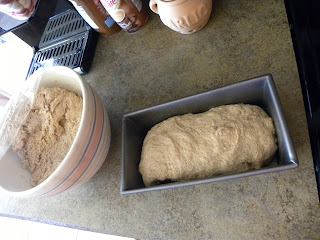The general premise is that you mix all of the ingredients together, let it rise for 2 hours, then dump the whole bowl in the fridge. You break off hunks of dough when you feel like having fresh bread. No kneading. Let me repeat: NO KNEADING. No drawn out marathons of rising and punching down bread, and it is even faster than bread machines. And the taste? Comparable to Panera Bread or Atlanta Breads, except at a tiny fraction of the cost. The only special equipment you'll need is a bread stone and a pizza peel, but the recipe I'll discuss here doesn't require either.
I started experimenting with the recipes (summary found here) just before Christmas so I could serve fresh crusty breads with soups and pasta for our guests. I got a very favorable response (what? you're saying my grandmother was biased? pshhhh.) and then I tried my hand at rosemary herb rolls--SO tasty! All using the base recipe.
For the last 2 weeks, we've been eating homemade whole wheat sandwich bread. The basic ingredients are:
1 1⁄2 tbsp granulated yeast (1 1⁄2 packets)
1 tbsp plus 1 tsp salt
1/2 cup honey
5 tbsp neutral-flavored oil, plus more for greasing the pan
1 1⁄2 cups lukewarm milk
1 1⁄2 cups lukewarm water
6 2⁄3 cups whole wheat flour
I dump all of this into my stand mixer with the dough hook attachment and let 'er rip for a minute or two. I will say that the one real trick is to microwave the milk and water for 1 minute, just to take the chill off. The little yeasties need a warm environment to wake up in, but if it's too hot, they'll die.
 And that's it! Let it sit covered with a towel for 2 hours to rise, and stick it in the fridge until you're ready to bake. I've been mixing up the dough after Joe goes to bed and popping it in the fridge just before I go to bed myself.
And that's it! Let it sit covered with a towel for 2 hours to rise, and stick it in the fridge until you're ready to bake. I've been mixing up the dough after Joe goes to bed and popping it in the fridge just before I go to bed myself.
I like to transfer the dough to another bowl, mainly because I use my stand mixer pretty frequently. My aunt gave me this large ceramic bowl a few years ago for Christmas because it belonged to my grandmother. She used it to make eggnog in, but since I don't really go for the nog, I figure it would get more use as my dough bowl.
 The dough can stay in the fridge for up to 2 weeks, and you can even freeze it in chunks. I haven't tried that yet, but I'll let you know how it goes if I do. When you're ready to bake, break off a chunk and shape it into a loaf. As I mentioned before, at this point you can shape the loaf on a pizza peel dusted with cornmeal and then toss it into a hot oven directly onto a bread stone, but for uniform sandwich slices, I use a loaf pan:
The dough can stay in the fridge for up to 2 weeks, and you can even freeze it in chunks. I haven't tried that yet, but I'll let you know how it goes if I do. When you're ready to bake, break off a chunk and shape it into a loaf. As I mentioned before, at this point you can shape the loaf on a pizza peel dusted with cornmeal and then toss it into a hot oven directly onto a bread stone, but for uniform sandwich slices, I use a loaf pan: Because I'm a health dork, I like to sprinkle wheat germ on top of the loaf for some added Vitamin E and fiber.
Because I'm a health dork, I like to sprinkle wheat germ on top of the loaf for some added Vitamin E and fiber. Let the dough sit in the pan for an hour and 40 minutes to rest (may or may not rise some more). I like to set out a loaf just after breakfast, that way it's rested, baked, and cooled just in time for sandwiches at lunch.
Let the dough sit in the pan for an hour and 40 minutes to rest (may or may not rise some more). I like to set out a loaf just after breakfast, that way it's rested, baked, and cooled just in time for sandwiches at lunch.Another trick for the perfect crust is to set an empty pan on the lowest rack in the oven and pour a cup (I use a cup and a half) of hot water into it just as you're putting the bread in. The steam gives a nice crunchy crust and keeps everything moist and yummy. Then sit back and enjoy the awesome smell for the next 50-60 minutes while the loaf bakes (at 350).
 And there you have it. Simple, tasty, cheap homemade bread. It literally takes less effort to make this every few days than it does to pack up and head off to the store. There are probably a few tweaks to make this even healthier, but I haven't read the sequel Healthy Bread in Five Minutes a Day yet. In the meantime, I'm enjoying my from-scratch sandwiches and toast (tastes awesome with my pumpkin butter) and I'm trying to see how long I can hold out before breaking down and heading to the grocery store. When that finally happens, it will be for more flour, trust me.
And there you have it. Simple, tasty, cheap homemade bread. It literally takes less effort to make this every few days than it does to pack up and head off to the store. There are probably a few tweaks to make this even healthier, but I haven't read the sequel Healthy Bread in Five Minutes a Day yet. In the meantime, I'm enjoying my from-scratch sandwiches and toast (tastes awesome with my pumpkin butter) and I'm trying to see how long I can hold out before breaking down and heading to the grocery store. When that finally happens, it will be for more flour, trust me.




So, I thought this sounded easy enough and looked good enough for me to try myself!
ReplyDeleteI just finished mixing it together and will let you know how it turns out. I do have one question though (seeing as how I've never baked my own bread before). I put the half used packet of yeast in a ziploc bag and put it in the pantry...will it still be good the next time I go to use it? What do you do with yours?
Thanks,
Mandi
Hey Mandi!
ReplyDeleteStick it in the fridge. I think in order to keep the yeasties alive in a dormant state, they need to be in a dark place and cool. Since I've been making this bread, I buy the yeast that comes in a jar (it's cheaper in the long run, and you can measure out exactly what you need) and it says to keep it in the fridge after opening. The glass on the jar is also tinted, which tells me that the yeast shouldn't be exposed to direct light.
Either way, the next time you go to use it, add it to the warm liquid and see if it starts to form bubbles. If so, it's still alive and good to go. If not, it's probably dead and you need new yeast. Good luck!
-k
Super easy and delicious! And dangerously good!
ReplyDeleteYay! I'm glad it turned out well for you. Tomorrow morning I'm going to pull out a hunk of dough from the fridge and bake up a loaf so we can have grilled cheese for lunch!
ReplyDelete